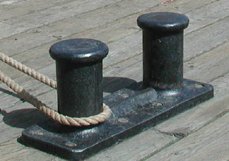Strakes:
The external hull of the ship consists
of a bottom shell, side shell and decks which are formed by longitudinal stripes
of plating known as strakes.
Garbode strake:
The strake adjacent to the keel on each
side of the ship is known as the Garbode strake and it is of the same thickness
as the bottom shell plating.
Sheer Strake:
The uppermost line of plating in the
side shell is known as the sheer strake which is 10% to 20 % thicker than the
remaining side shell plating.
Bilge Keel:
It is a piece of bulb plate fitted
normal to the vessel's shell plating surface along the line of the bilge
diagonal and designed to dampen out rolling motions.
Bollard:
It is a single cast steel post securely
fastened to the ship's deck to act as a securing point for the mooring lines.
Bulwarks:
- Bulwarks
are fitted on the weather decks, which are provided as protection for
personnel and are not indented as a major structural feature.
- It
should be at least 1m high on the exposed freeboard and superstructure
decks, but a reduced height may be permitted if this interferes with the
working of the ship.
Freeing Ports:
Freeing ports is fairly opening through
bulwarks fitted with protection bars or a self-closing lid to allow seawater to
run overboard.
Centre Grider:
A primary structural vertical plate
fitted on the centreline immediately above the keel plate in a vessel.
Cofferdam:
A Void space between the two bulkheads
or decks designed in order to safeguard against intermixing of liquids between
two adjacent compartments due to leakage.
Coffin Plate:
- They
are used to connect stern frames to the flat plate keel.
- The
stern frame is extended forward far enough to provide a good connection
with a flat plate keel.
Duct Keel:
An internal passage of watertight
construction running the same distance along the length of the ship, often from
the forepeak to the forward machinery space bulkhead.
Stringer Plate:
The outboard deck strake is known as
the stringer plate and the weather deck is usually thicker than the remaining
deck plating
Bulbous Bow:
A bulb-shaped underwater bow which is
designed to reduce wave-making resistance and any pitching motion of the ship.
Devils Claw:
A stretching screw with two heavy hooks
or claws which is used to secure anchor in the hawse pipe.
Hawse Pipe:
A cast steel tube running through the
forecastle to the vessel's forward through which the anchor chain is rove.
Spurling Pipe:
A tube fitted under the forecastle deck
to carry the anchor chain from under the windlass to the top of the chain
locker.
Margin Plate:
The outermost strake of the inner
bottom or tank top and when turned down to bilge the plate forms the outer
boundary of the double bottom tank.
Chain Locker:
A compartment usually positioned
forward of the collision bulkhead and is used to accommodate the volume of
chain cable attached to each ship.
Breast hooks:
The stem plate is supported at an
interval of about 1.5 m by horizontal plates known as Breast hooks, which
extend from the stem to the adjacent transverse frame.
Cable Stopper:
The cable stopper is a casting with a
hinges lever, which may be used to lock the cable in any desired position and
thus relieve the lord of the cable from the windlass either when an anchor is
out or when it is stowed.
Reference: Ship Construction By D.J, Eyres
Ship Construction for Marine Students By E.A.Stokoe









0 Comments
Thanks for your Valuable comments and Suggestions